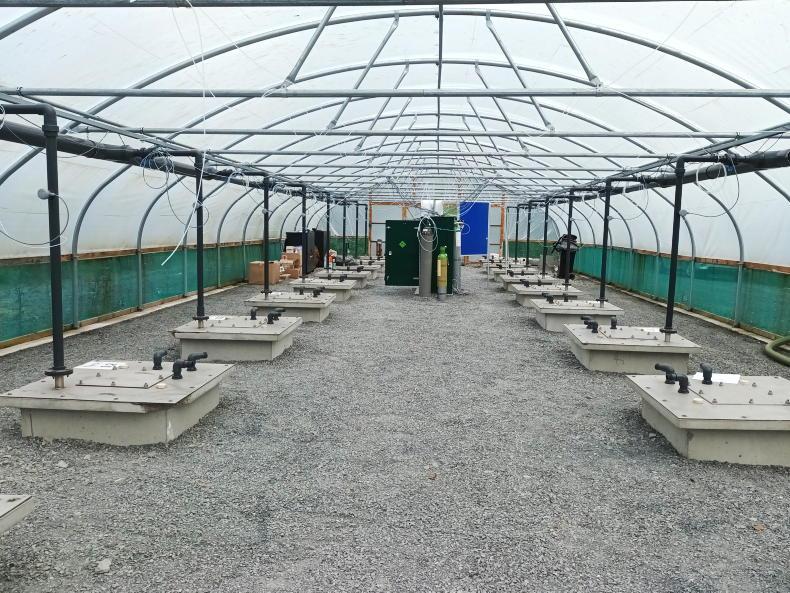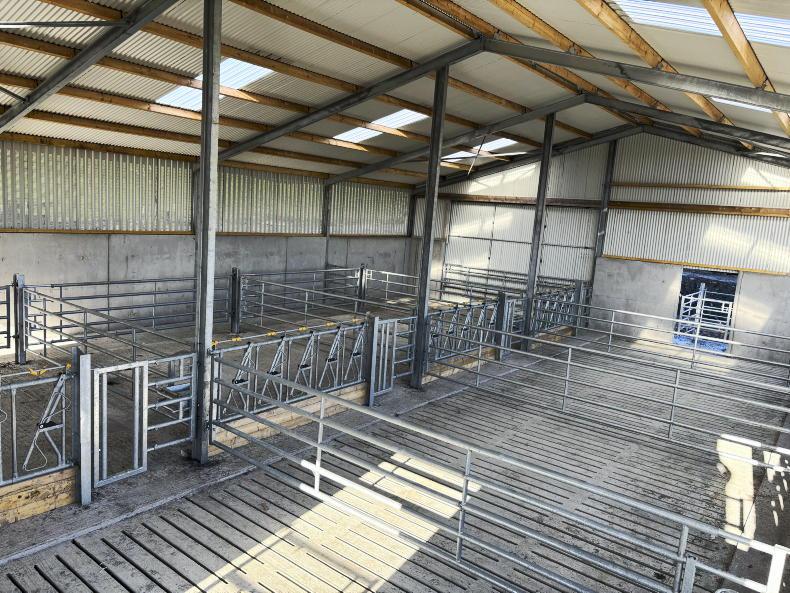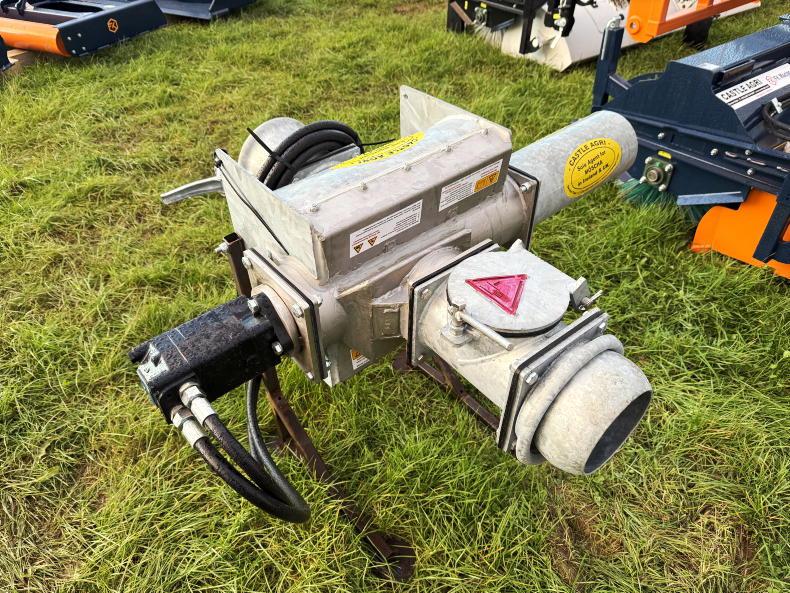Measures introduced in the Department of Agriculture’s Climate Action Plan back in 2020 meant that from 1 January 2022, all newly constructed external slurry stores are required to be covered.
In addition, all existing external slurry stores should be covered as soon as is practically possible, but no later than 31 December 2027.
This measure is an effort to reduce ammonia losses from the stores, keeping more of the valuable nitrogen in the slurry, with the added benefit of a reduction in chemical nitrogen usage. Agriculture is responsible for 99% of the country’s ammonia emissions.
The rate of ammonia loss is influenced by the air moving over the top of the slurry, so covers will likely be required to prevent air from coming into contact with the slurry.
This means two things: it is not a requirement that the cover prevents rainwater entering the slurry storage; but it also means that evaporation of water (which can be as high as 30%) will likely be reduced with any introduction of a cover.
Concrete slats and roofing
Existing uncovered concrete tanks can be converted to uncovered or covered slatted areas through the use of reinforced concrete spine walls or pillars.
A slatted outdoor tank reduces ammonia losses by an estimated 60% compared to an uncovered tank, so the use of slats over these open tanks is viewed as a viable cover for this reason.
On a m³ basis, concrete tanks with slats are working out at €110/m³. To construct a high-quality, TAMS spec roof (cement fibre sheeting, steel purlins) over this tank will cost in the region of €70/m².
If we are to take this m² area, we can expect roughly 500mm of rain to fall on this area over a four-month closed period (1 October to 1 February). Along with this 500mm, an additional 100mm of freeboard is required for open tanks over the 200mm required for covered tanks.
What this essentially means is that 600mm of tank depth, whatever depth it is, in an uncovered tank is lost to water. Taking this 600mm depth and using our cost of €110/m³ for creating storage, the net loss is €66/m³.
Difficulties in covering stores
Concrete tanks and slurry towers are relatively easily covered, but the difficulty arises when it comes to lagoons.
Floating covers are available that will reduce the ammonia loss from these, but there is no option to reduce the volume of rainfall entering these lagoons.
Lagoons are still an excellent option for large volumes of slurry (over 400,000 gallons) but again, much of this can be lost to rainwater, especially with the cambered sides of lagoons.
The economics of roofing versus creating more open slurry storage are marginally in favour of more slurry storage, but the additional benefits of roofing over these tanks should also be considered.
In a 2.4m deep tank, we can expect the rainfall of 500mm to enter the tank and then 20% of the storage is lost to water.
In a slatted tank with a net capacity of 100,000, 20,000 gallons of water now needs to spread, be it through umbilical or by tanker.
Taking a cost of spreading using a tanker of €75/hour at 6,000 gallons/ hour (three 2,000-gallon tankers), then the cost to spread this 20,000 gallons of water equates to €247.50 annually.
Accumulative cost
While it does seem a marginal cost, the accumulative cost of spreading water, with no nutrient value, over the lifespan of the tank needs to be taken into account.
While some may argue that a higher water concentration will leave slurry easier spread for LESS equipment, the majority of dairy-derived slurry has a low dry matter as standard.
Diluting this slurry with additional water is lowering the nutrient value further.
Soiled water storage requirements have been increasing annually over the last number of years, with creamery farmers now requiring four weeks of storage to comply with the closed period of 1 December to 31 December.
Those on a liquid milk contract have until 2025 to comply, with the current requirements for these farmers sitting at 21 days.
The key consideration that farmers need to take into account with soiled water is keeping it separate from slurry stores, meaning that a separate, dedicated tank for soiled water from parlour washing needs to be in place.
When soiled water enters a slurry tank and mixes with slurry, then it is now considered slurry as it has broached the 1% dry matter level content barrier.
This water then has to be stored for a 16–22-week period (depending on county zones) which significantly increases storage requirements.
In short
Climate Action Plan 2020 states that all newly constructed external slurry stores must be covered.In addition, all existing external slurry stores should be covered no later than 31 December 2027.Rainfall entering uncovered tanks can account for a 20% loss in storage.Roofing uncovered concrete tanks is marginally more costly than creating more storage.
Measures introduced in the Department of Agriculture’s Climate Action Plan back in 2020 meant that from 1 January 2022, all newly constructed external slurry stores are required to be covered.
In addition, all existing external slurry stores should be covered as soon as is practically possible, but no later than 31 December 2027.
This measure is an effort to reduce ammonia losses from the stores, keeping more of the valuable nitrogen in the slurry, with the added benefit of a reduction in chemical nitrogen usage. Agriculture is responsible for 99% of the country’s ammonia emissions.
The rate of ammonia loss is influenced by the air moving over the top of the slurry, so covers will likely be required to prevent air from coming into contact with the slurry.
This means two things: it is not a requirement that the cover prevents rainwater entering the slurry storage; but it also means that evaporation of water (which can be as high as 30%) will likely be reduced with any introduction of a cover.
Concrete slats and roofing
Existing uncovered concrete tanks can be converted to uncovered or covered slatted areas through the use of reinforced concrete spine walls or pillars.
A slatted outdoor tank reduces ammonia losses by an estimated 60% compared to an uncovered tank, so the use of slats over these open tanks is viewed as a viable cover for this reason.
On a m³ basis, concrete tanks with slats are working out at €110/m³. To construct a high-quality, TAMS spec roof (cement fibre sheeting, steel purlins) over this tank will cost in the region of €70/m².
If we are to take this m² area, we can expect roughly 500mm of rain to fall on this area over a four-month closed period (1 October to 1 February). Along with this 500mm, an additional 100mm of freeboard is required for open tanks over the 200mm required for covered tanks.
What this essentially means is that 600mm of tank depth, whatever depth it is, in an uncovered tank is lost to water. Taking this 600mm depth and using our cost of €110/m³ for creating storage, the net loss is €66/m³.
Difficulties in covering stores
Concrete tanks and slurry towers are relatively easily covered, but the difficulty arises when it comes to lagoons.
Floating covers are available that will reduce the ammonia loss from these, but there is no option to reduce the volume of rainfall entering these lagoons.
Lagoons are still an excellent option for large volumes of slurry (over 400,000 gallons) but again, much of this can be lost to rainwater, especially with the cambered sides of lagoons.
The economics of roofing versus creating more open slurry storage are marginally in favour of more slurry storage, but the additional benefits of roofing over these tanks should also be considered.
In a 2.4m deep tank, we can expect the rainfall of 500mm to enter the tank and then 20% of the storage is lost to water.
In a slatted tank with a net capacity of 100,000, 20,000 gallons of water now needs to spread, be it through umbilical or by tanker.
Taking a cost of spreading using a tanker of €75/hour at 6,000 gallons/ hour (three 2,000-gallon tankers), then the cost to spread this 20,000 gallons of water equates to €247.50 annually.
Accumulative cost
While it does seem a marginal cost, the accumulative cost of spreading water, with no nutrient value, over the lifespan of the tank needs to be taken into account.
While some may argue that a higher water concentration will leave slurry easier spread for LESS equipment, the majority of dairy-derived slurry has a low dry matter as standard.
Diluting this slurry with additional water is lowering the nutrient value further.
Soiled water storage requirements have been increasing annually over the last number of years, with creamery farmers now requiring four weeks of storage to comply with the closed period of 1 December to 31 December.
Those on a liquid milk contract have until 2025 to comply, with the current requirements for these farmers sitting at 21 days.
The key consideration that farmers need to take into account with soiled water is keeping it separate from slurry stores, meaning that a separate, dedicated tank for soiled water from parlour washing needs to be in place.
When soiled water enters a slurry tank and mixes with slurry, then it is now considered slurry as it has broached the 1% dry matter level content barrier.
This water then has to be stored for a 16–22-week period (depending on county zones) which significantly increases storage requirements.
In short
Climate Action Plan 2020 states that all newly constructed external slurry stores must be covered.In addition, all existing external slurry stores should be covered no later than 31 December 2027.Rainfall entering uncovered tanks can account for a 20% loss in storage.Roofing uncovered concrete tanks is marginally more costly than creating more storage. 








SHARING OPTIONS